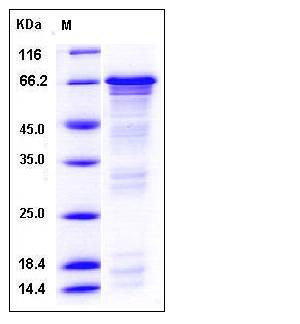Human HSF1 / HSTF1 Protein (His Tag)
HSTF1
- 100ug (NPP3928) Please inquiry
| Catalog Number | P12245-H07E |
|---|---|
| Organism Species | Human |
| Host | E. coli |
| Synonyms | HSTF1 |
| Molecular Weight | The recombinant human HSF1 consisting of 539 amino acids and has a calculated molecular mass of 58.6 kDa. It migrates as an approximately 67 kDa band in SDS-PAGE under reducing conditions. |
| predicted N | Met |
| SDS-PAGE |  |
| Purity | > 70 % as determined by SDS-PAGE |
| Protein Construction | A DNA sequence encoding the human HSF1 isoform long (Q00613-1) (Asp 2-Ser 529) was expressed, with a polyhistide tag at the N-terminus. |
| Bio-activity | |
| Research Area | Immunology |Signal Transduction |Other Related Intracellular Topics |Cellular Senescence and Pathways in Aging |Apoptosis |Nucleus protein | |
| Formulation | Lyophilized from sterile PBS, pH 7.0 1. Normally 5 % - 8 % trehalose and mannitol are added as protectants before lyophilization. Specific concentrations are included in the hardcopy of COA. |
| Background | Heat shock factor protein 1, also known as heat shock transcription factor 1, HSF1 and HSTF1, is a cytoplasm and nucleus protein which belongs to the HSF family. HSF1 is the major transcription factor of HSPs (heat shock proteins) in response to various stresses. Wild type HSF1 (heat shock transcriptional factor 1) is normally inactive. HSF1 / HSTF1 is a DNA-binding protein that specifically binds heat shock promoter elements (HSE) and activates transcription. In higher eukaryotes, HSF is unable to bind to the HSE unless the cells are heat shocked. HSF1 / HSTF1 protects cells and organisms against various types of stress, either by triggering a complex response that promotes cell survival or by triggering cell death when stress-induced alterations cannot be rescued. HSF1 / HSTF1 is the key protein in regulating stress response. It can be activated under heat, oxidative or another stress conditions. Dominant-positive and dominant-negative HSF1 are two types of HSF1 mutants. Both of them gain the DNA binding activity in the absence of stress. In addition, dominant-positive HSF1 acquires transcriptional activity, which dominant-negative HSF1 does not acquire. HSF1 / HSTF1 was also reported to contribute to cell resistance against genotoxic stress, such as that caused by doxorubicin, an anticancer drug in common clinical use. |
| Reference |
